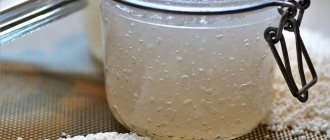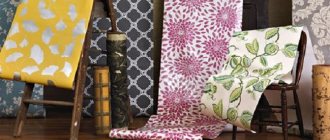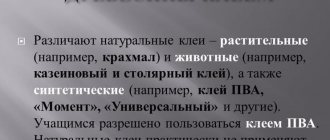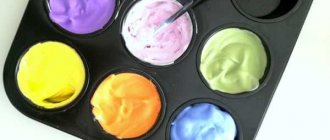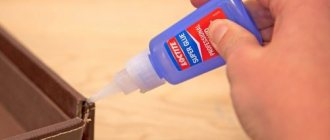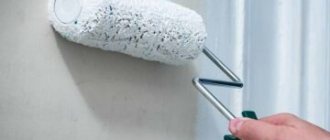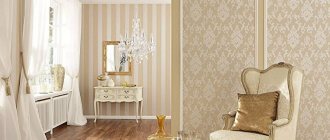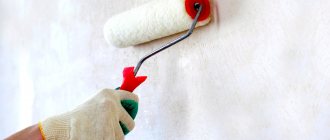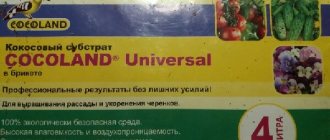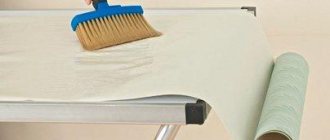It doesn’t matter what wall coverings you use when repairing and finishing your apartment: paper, non-woven, vinyl or acrylic. To glue them you will need special glue. Fortunately, the choice is now huge. Do you want to save money on repairs or are you allergic to glue from the hardware store? We advise you to make your own wallpaper paste. It has no disadvantages, regardless of the method of preparation and composition (flour or starch), but it has many positive qualities:
- low cost of components (the most budget option made from flour or starch is suitable),
- environmentally friendly,
- completely safe for health (even a child can use this adhesive composition), hypoallergenic,
- self-made glue will also save on wall primer by replacing it,
- if it is necessary to remove the wallpaper in the future, it is enough to moisten it with warm water,
- such an adhesive composition does not turn yellow over time and does not leave stains,
- it can be used as an analogue of glue for paper, papier-mâché and even corrugated cardboard.
Do not forget to prepare a sufficient amount of paste for preliminary “priming” of the walls.
Flour paste
Wallpaper paste made from flour is a universal popular product that is suitable for almost any type of wall covering. Whatever method you choose, each will contain water and grade 1 or 2 flour. Sometimes wood glue or PVA glue is also added.
The simplest recipe for wallpaper paste made from flour is simple. It is enough to take flour (the highest or even 1st grade is not needed here, you can limit yourself to 2) at the rate of 2 tablespoons per 1 liter of warm water. Put water on the stove, add flour and cook with constant stirring. For “one serving” 5 minutes of cooking is enough. The recipe is suitable for gluing light wallpaper and gluing paper.
There is a more complex method of preparation. It is recommended to use when using medium and heavy wallpaper. The difference is in proportions.
Mix flour and water in a ratio of 1:3. It is advisable to take warm, but not hot water. This way the flour will dissolve better. Place the container with the mixture on the stove and cook over low heat until it boils, stirring constantly. Now we filter the composition and cool. After cooling, your glue is ready for use.
Flour paste with PVA glue
Now let's talk about how to make a paste from flour for wallpaper with the addition of PVA glue. This will make it resistant to water. Removing wallpaper from the walls will become more difficult, and the maximum weight of the wallpaper will increase. We recommend using it with heavy wall coverings.
Take 200-250 grams of flour and add a little water to it. Do not forget to constantly stir the future glue. The resulting lumps should be broken up or removed. After this, add warm water to the composition, bringing the volume to 1 liter. If the mixture seems too thick, use hot water.
Do not add water immediately to avoid lumps forming. Now take half a cup of PVA glue (or regular wood glue) and pour it into your composition. Stir and continue cooking until bubbles form. If necessary, strain the resulting mixture through a sieve or cheesecloth.
Wait a few minutes for the adhesive to cool. Now you can start working with it. If a film/foam forms on the surface as it cools, remove it.
Surprisingly, when using flour wallpaper glue, you don't have to completely dry the walls. Just use rye flour instead of wheat flour (2 kilograms per 1 liter), and then add hot water to 8-9 liters and 600 g of turpentine.
Paste as an alternative to commercial wallpaper adhesives
It is not at all difficult to make effective and reliable wallpaper adhesive with your own hands without the use of chemical additives or special equipment. The need for a homemade adhesive composition arises in the following situations:
- I've run out of purchased glue. Repair work often drags on until late, when all the stores are already closed, making it impossible to purchase new goods. That's why you have to make the glue yourself. And the process of preparing it takes as much time as going to the store.
- High price of production composition. Reviews from craftsmen who regularly make paste with their own hands directly indicate that with equal volumes of homemade and purchased products, the former is an order of magnitude cheaper.
- Lack of universal glue in the store. In such a situation, choosing the right composition for a specific type of wallpaper is quite difficult. But you can easily add an additional ingredient to the paste you prepare yourself, making the composition ideal for light or heavy wallpaper, as well as other materials.
- The health hazards of purchased products. During the production of industrial adhesives, all sorts of harmful additives are added to them, which in no case should be inhaled for a long time. Homemade paste contains only environmentally friendly components, and besides, the manufacturer knows exactly what he adds to the composition.
Starch paste
Making wallpaper paste from starch is as easy as making paste from flour. This composition is perfect for thin and ultra-thin wallpaper. The recipe is considered more economical than flour paste.
The classic recipe for starch paste for wallpaper is this: take starch and water in a ratio of 1:9. Sift it through a fine sieve. Add water to the prepared starch, remembering to constantly stir the composition. Now place the container on the stove and cook over low heat, stirring constantly. Some experts advise preparing a starch paste in a water bath. The most important thing is good mixing of the components.
If you want to add moisture resistance to the glue, use ½-1 cup of PVA glue.
Don't forget to strain the resulting mixture through a sieve or cheesecloth.
Preparation methods and compositions
The thickness of dilution of the adhesive powder depends on the type of wallpaper; the heavier the canvas, the less water needs to be added.
Not so long ago, our grandmothers and mothers glued all the wallpaper with paste, without using ready-made mixtures. Making glue with your own hands is not difficult.
Eco-friendly glue, prepared at home, does not lose its position even today. By using it, you can be absolutely confident in the safety of the adhesive composition.
It may contain both starch and flour, or you can use only one product. Depending on the type of wallpaper, a solution of varying density is prepared.
If desired, the paste can be strengthened by adding a little PVA or wood glue to it. These additives will make ordinary paste more resistant to moisture.
PVA paste
This type of adhesive composition is considered the most expensive. But it also surpasses its counterparts in quality. He is not at all afraid of water. After using it, you will have to remove the wallpaper along with the plaster. In addition, the shelf life of such glue is almost unlimited (the main thing is to prevent air from entering the finished composition).
So, dilute the PVA glue with cold (!) water in a ratio of 1:2. Mix thoroughly until you obtain a creamy consistency. Now the paste can be used.
What it is
Paste is a homemade gelatinous adhesive. The composition is used in needlework and, less often, in repairs (mainly for wallpapering). It contains no harmful additives, which cannot be said about industrial products. It is thanks to safety that the paste is still relevant. It replaces PVA well.
What are the advantages of making and using paste for modern people:
- This is an environmentally friendly product. All stages of preparation are traced. You can be sure that the composition is safe, unlike what the chemical industry offers.
- Paste replaces expensive glues, its cost is very low, in fact, it is equal to the cost of flour or starch.
- Easy to prepare, products are available at any time.
- Practical and easy to use composition.
- If you need to remove wallpaper glued to paste, it will not be difficult: just wet the walls, and the coating will come off without leaving a trace.
One of the disadvantages is the short shelf life. At room temperature it should be used within 24 hours. If you put it in the refrigerator, it will stay there for 2-3 days, but it will still spoil and you will have to throw it away.
To prepare the paste, a minimum of products are used: ordinary wheat / rye flour or starch. To make the composition as convenient as possible for use, you need to adhere to some principles in choosing components and tools:
- Flour is chosen of low quality. It is this product that gives the adhesive mass the necessary viscosity. Flour of the highest grade will not provide the glue with the required consistency.
- Before use, sift the flour through a sieve to remove lumps.
- In order for the mass to mix well, you will need a mixer or blender. But it is permissible to stir with a metal spoon - the main thing is that there are no lumps.
- The pan or basin is non-stick.
Cooking errors
The quality of the paste depends on compliance with the technology of its preparation. But often beginners make mistakes when cooking and get negative results. The following mistakes prevent you from making a high-quality paste:
- Add dry starch directly to boiling water. The gluten sets instantly, and the mass turns out with lumps.
- Neglecting stirring. To evenly distribute the dry matter, the paste must be stirred intensively and continuously when heated. If you linger for a minute, the mass will turn into a lump.
- Adding dry powder to water. This provokes the formation of lumps. You need to do the opposite: pour water into the starch.
Water repellent additives
Thermosetting additives are used to impart hydrophobic properties. Necessary in the manufacture of corrugated cardboard and products made from it. Improves seam strength and product quality.
The most widely used additives are the CP-88 series. They reduce glue consumption. The use of CP-88 allows corrugated cardboard products to maintain a seam in an atmosphere with high humidity.
Read also: How to cook delicious shish kebab
In everyday life, such additives are used when gluing wallpaper in damp rooms. When adding the substance, keep the windows open. The quality of the resulting solution is not inferior to expensive wallpaper adhesives.
How to cook it yourself: instructions
For initial mixing, you can use any available tool, including a whisk.
So, how to cook wallpaper paste? In this article we will look at the 2 most common recipes. As for the gluing process itself, you can find out more detailed information about this from this article.
We make it using starch
It is this composition that leaves behind the least amount of stains, even with somewhat sloppy gluing. To be more precise, it leaves no stain at all. It is for this reason that they can be used to glue wallpaper of any color: from dark to light tones. So, here are brief instructions on how to prepare it yourself:
- Having bought ordinary starch (this can be done at any store), the first thing you need to do is sift it. As for the volume of the future paste, for each kilogram of composition you will need 100 grams of starch.
- After sifting, you need to add water to the starch, stirring the composition a little. As a result, you should get a substance of uniform consistency that resembles sour cream.
- After preparation, it is necessary to act as quickly as possible, since this glue hardens quite quickly.
- Pour the contents into a metal bowl (use a basin or bucket) and while stirring vigorously, add a small amount of boiling water. After everything is mixed, you can strain the mixture through cheesecloth to sift out any lumps. This will help improve adhesion and avoid bubbles on the wallpaper.
- In addition, the paste can be cooked using the water bath method. During the cooking process, it must be stirred until bubbles appear on the surface. Then turn off the heat and cool the contents of the dish.
Interesting to know! It is entirely acceptable to use paste as a primer when preparing walls for wallpapering. At the same time, it can be diluted with additional water.
Main ingredients for glue
If you go into some fairly old house, where renovations were done at least twenty years ago, the question automatically pops up in your head: “What kind of glue was that, so that after a year the wallpaper holds up just perfectly?” First, it should be mentioned that wallpaper paste was made right in the kitchens of houses. The following main components were often taken:
- Potato starch;
- Any type of flour;
At first glance, it may seem that this is some kind of nonsense and that heavy wallpaper will not be able to adhere to starch or flour. However, these components are famous for their adhesive properties due to a known component called gluten.
Advantages and disadvantages
Important
Modern adhesives for wallpapering have a significant drawback - they are inconvenient for working on surfaces primed with drying oil or walls covered with old paint. Only a paste can handle such a base during repairs.
Thanks to its main advantage - the ability to easily remove wallpaper pasted with its use - it is still used on a par with professional building mixtures. Among other advantages of a homemade recipe, the following are also mentioned :
- effective adhesive property;
- easy dismantling process (soaking with warm water);
- the ability to wash stains without problems;
- quick preparation of the mixture, which does not require special skills;
- a minimum set of cheap ingredients;
- long-term operation.
The only drawback of the paste is its instability to moisture , so even a beautiful renovation runs the risk of being ruined due to water getting on the finished walls. But even this problem can be overcome if you add special additives when cooking the paste (usually simple PVA glue or a similar binding element that will add strength).
Another drawback is the short shelf life, which is also related to the problem of humidity. It is needed to make economical cosmetic repairs or to be able to frequently change the color of the walls. The paste will eliminate problems with removing old layers.
Homemade flour glue has many more positive aspects . In terms of price, it is cheaper than branded store brands, completely safe in everyday life (non-toxic, no pungent odor, fire resistant) and mixes within a few minutes, then you can immediately proceed to the stage of gluing the wallpaper itself.
